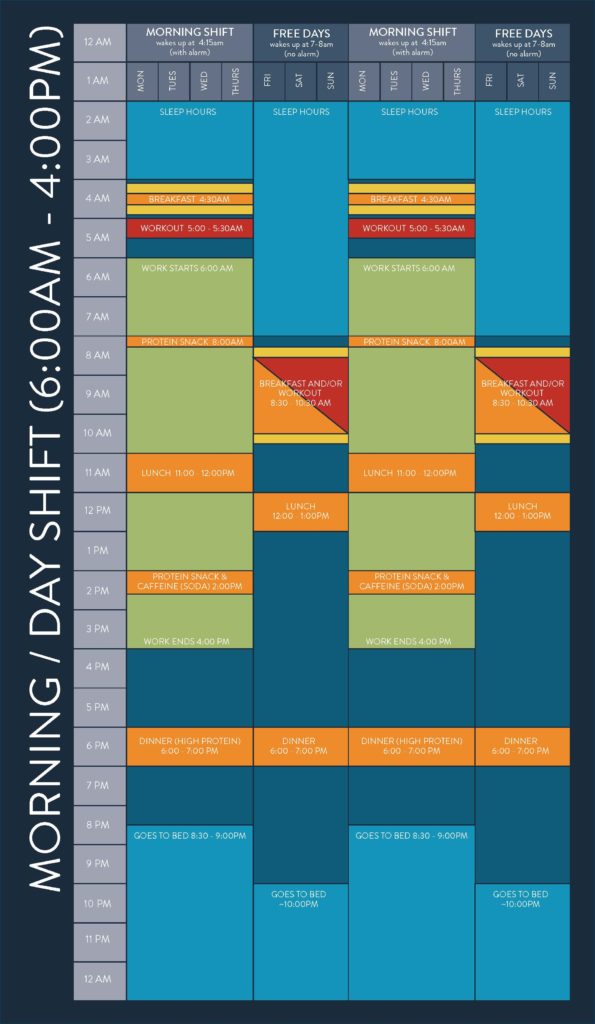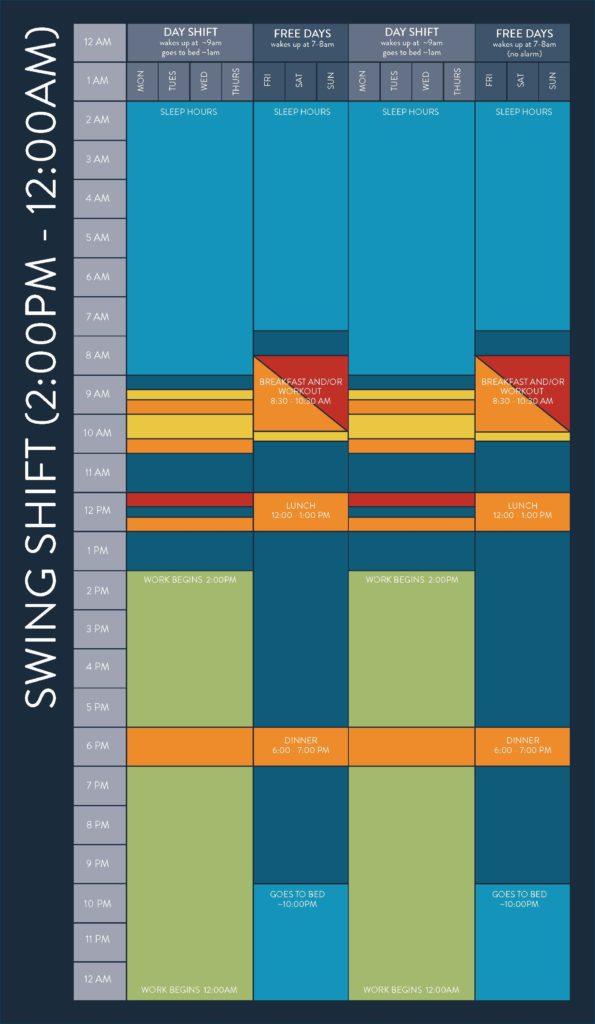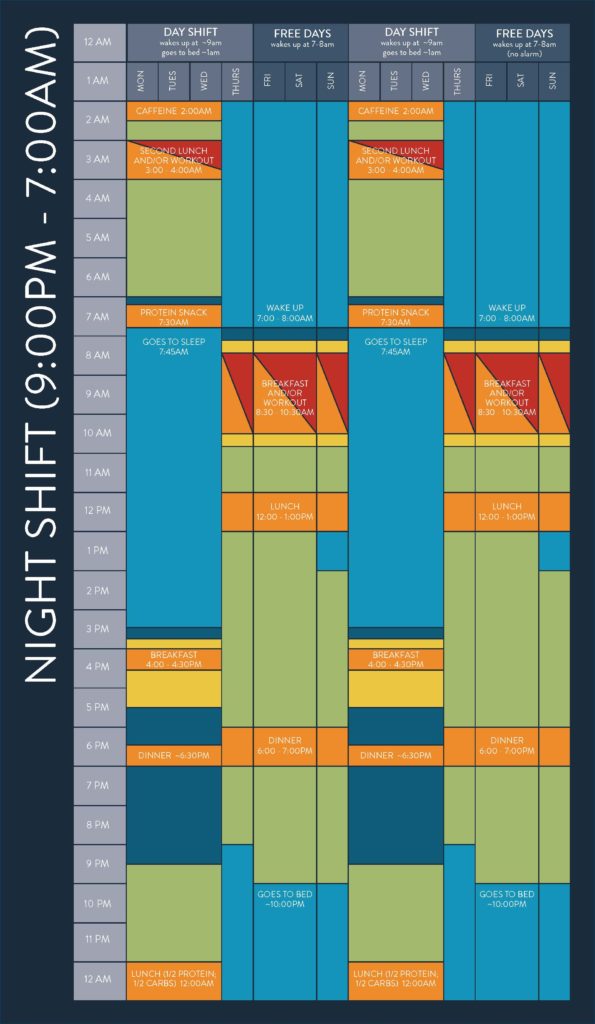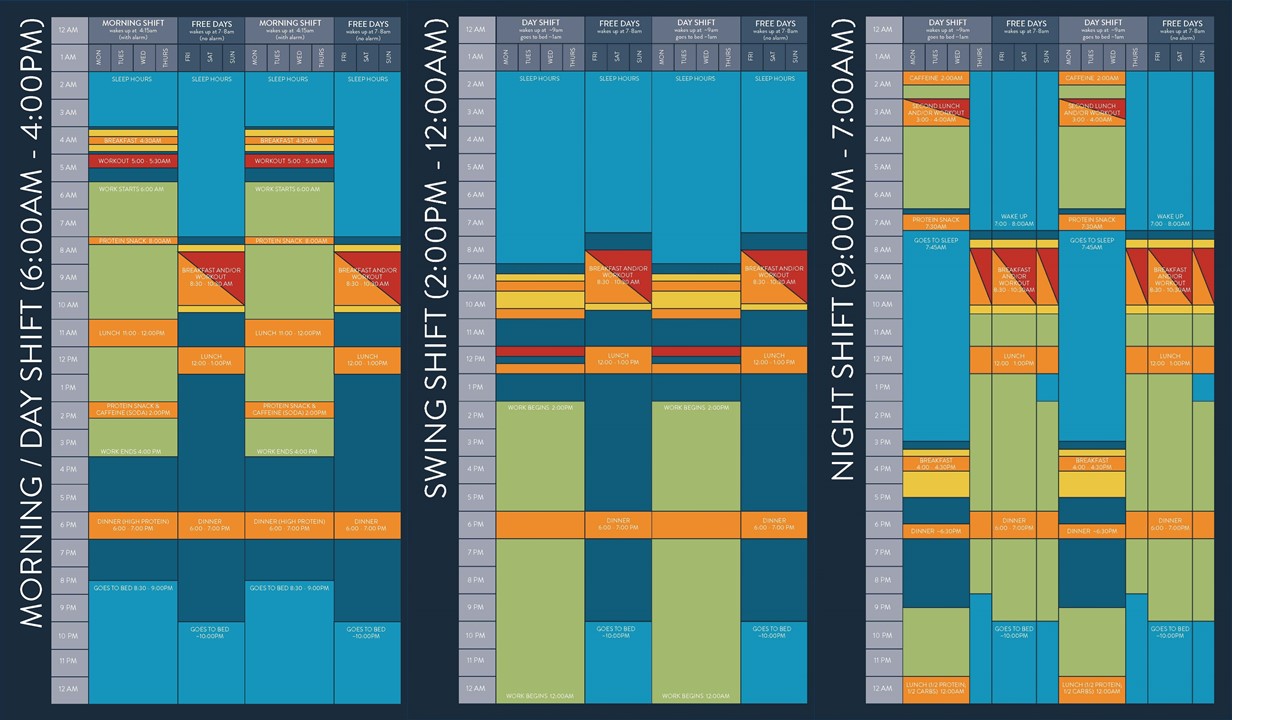Author: Emily Manoogian, PhD
Cory Mapston is a Sergeant of San Diego Police Department and has been on a rotating shift work schedule for the past 28 years. Shift work can be both mentally and physically challenging, but Cory has found a way to make it work. He even serves as a peer mentor for other officers. Cory, and his wife Dona, kindly sat down with us to share their wisdom of living well on a shift work schedule that they learned from a life of trial and error.
The San Diego Police Department works on 3 different shifts (morning, swing, and night), each with their own challenges. Officers will stay on each shift for 4 months at a time, because it is about the amount of time someone can hold it together. As Cory puts it, “4 months I can handle; 5 months I’ll start to go crazy.” Every time they rotate to a new shift, their free days rotate as well. If they had Fri, Sat, Sun off for one shift, the next shift they will have Tues, Wed, Thurs off, then back to Fri, Sat, Sun. This is another reason that they don’t do more than 4 months on a given shift. Even on an ‘easier’ shift, it’s hard to give up all of your weekends for more than 4 months.
Although shift-work will never be easy, Cory has found a way to optimize his schedule. He has a few key habits that anyone can apply to their own lives, regardless of schedule: get a lot of sunlight, be active every day, eat protein, and get good sleep.
Seeking light
Light has a huge influence on your biological clocks to help you coordin
ate your internal timing with the environment. Light can also greatly influence your mood, which is why some people experience seasonal affective disorder in the winter. For Cory, getting enough sunlight is crucial, “When I wake up on a workday, I immediately seek the sun. I get my cup of coffee and I go outside…If I don’t get enough sun, I’m a bear.” Cory also prefers to get exercise with outdoor activities such as paddle boarding, running, hiking, or even outdoor weight lifting, rather than going to a gym. “The same exact workout outdoors gives me twice the psychological benefit [as working out indoors].”
Getting enough light during the summer usually is not a problem, regardless of shift. However, if he’s on the night shift in the winter (mid sept-mid Jan), he may go 4 days without seeing the sun. “It is absolutely the toughest shift,” explains Cory’s wife Dona.
Luckily, Cory and Dona stumbled upon a partial solution to this lack of light. One winter, in preparation for a sunny vacation, they went to use tanning beds. Dona noticed a dramatic improvement in Cory’s mood. Now, when Cory can’t get enough sun light, he will go to a tanning bed to help get enough light. Only 8 minutes is enough to make a difference. It still is not the same as a sunny day, but it is an important light substitute when needed. Getting enough light is a crucial aspect of health for Cory, “I seek light…it’s like a hobby.”
Free days
Regardless of his shift, Cory tends to keep a similar timeline for his free days. He gets up sometime between 7-8 am (no alarm clock), has coffee, actively seeks sunlight, and in the first couple hours eats breakfast and gets a workout in, outside if possible (sometimes in reverse order). He has lunch around noon, dinner sometime between 6-7pm, and gets to sleep around 10pm. He will have a protein snack in the afternoon, but aside from that he doesn’t snack much. His vice is the occasional few drinks at night. On average, he eats over a 10 to 12-hour interval, sleeps for ~9 hours/night (no sleep aid or alarm), and works out every day.
Morning Shift: 6am-4pm
The morning shift is one shift that is a bit easier mentally because you can still have a regularly normal social life and see your family. However, physically, it is a bit of a strain. To be ready in time for the morning shift, Cory wakes up at 4:15pm (with the help of an alarm); about 3 hours earlier than his natural schedule. This 3-hour shift is the same as flying from LA to New York. May not seems like the worst thing if you do it once, but fly back and forth every 4 days for 4 months and then see how you feel.
Per the usual, Cory starts his day by seeking light, (if the sun isn’t up yet, then any alternative he can find) has breakfast, gets a workout in between 5-5:30am and is ready for line up at 6am. Due to the early 4:30 am breakfast, he follows up with a protein boost at 8am, followed by lunch around his normal time 11:00am-noon, a caffeine and protein boost at 2pm. Work ends at 4pm and Cory can eat dinner at his normal time (6-7pm) with Dona. Due to the early wake up, he turns in earlier, ~ 8:30-9pm.

Swing Shift: 2pm-12am
The swing shift is physically the easiest shift for most. It is easy to get a lot of sunlight at the beginning of your day and most people are better able to stay up a bit later and sleep in the next day. For Cory, it’s only about a 2-hour transition between shifts and free days, and he may start his free days a bit later than normal to decrease that phase shift.
Unfortunately, the swing shift can be very challenging for maintaining a social life, especially if your free days are not on weekends. Due to incompatibility with a 9-5 schedule, it can result in a 4 days in a row without seeing your family and friends. If you have weekend free days, you can spend all day with your family/friends, but if your free days are on weekdays, the most you can hope to see them is a few hours at night. This can lead to a very stressful home life. Despite these potential mental strains, it is still the preferred shift by most officers.
Cory keeps his normal schedule when on the swing shift, he just shifts it back a bit. He wakes up around 9am (no alarm), seeks light, gets coffee and eats breakfast. He tries to get in a good outdoor workout around noon, eats lunch, and starts work at 2pm. Work ends at 12pm, so he gets to bed around 1am. Although he usually switches back to waking up earlier and going to sleep earlier on his free days, there is flexibility there. This is a shift that never needs and alarm clock and when Cory feels like he has the most vigor.
Night Shift: 9pm-7am
For Cory, the night shift starts at 9pm and goes til 7am. This is by far the most difficult shift (physically and mentally) and it is pretty obvious why. You are forcing your body to be active and alert at the same time it is usually ready to slow down and sleep. It is a 7 to 9-hour delay of schedule. That’s equivalent to traveling from California to Paris.
Due to this time change, some people try to stay on the night shift schedule even on free days. Cory and Dona tried staying on the night shift full time, but it didn’t work for them. Cory explained, “Officers have two strategies. They either get up during the day and see their families or they try to stay on the graveyard schedule on their free days as well. I find the officers that are on that schedule are far less successful. They have more sick days, they have more negative impacts on their life that you can start to see through alcohol use and relationship problems. All of the people who try the night owl routine are not as successful.”
Staying on the night schedule does not work for many people due to social reasons as well as other logistical reasons. Loud cities, construction, neighbors, children, pets, weather, and light control can make it hard to near impossible to find a quiet, dark, cool room to sleep in the middle of the day.
The Mapstons know that different coping strategies work for different people. Dona explained their current methods are from a long series of trial and error, “The current way that we do the night yard shift is the result of 28-years of figuring out what works for him.”
To help with day time sleep, they sound proofed their bedroom, have a great AC and use black
out curtains. They have learned that an optimal sleeping environment play a big role in the quality and quantity of sleep for Cory.
As with his other schedules, Cory maintains normal times for free days (wake up around 7-8am and goes to bed around 10pm). On the first day of a night shift, he still gets up at in the morning, but he will try to take a nap in the afternoon (~1-2pm) before starting his shift at 9pm. That first night can be hard. Aside from the 1 to 2-hour nap that afternoon, he will be awake for 24 hours straight.
The morning shift ends at 7am. Contrary to what we would expect, he still tries to get a lot of light exposure on the way home. He gets to bed around 7:45am and tries to get as much sleep as he can. He usually wakes up around 4pm and keeps his normal schedule (lots of light in the first few hours of the day, breakfast, etc.). Some changes include when he exercises and when he eats specific meals. Cory switches his lunch and dinner so he can still eat dinner with Dona around 6:30 pm and then has his typical lunch around midnight. He’ll follow that with a caffeine boost around 2am and then gets his workout in (and maybe a second lunch/snack) around 3-4am if he has time.
Cory will keep that schedule for a couple of days and then on the last day of night shift, instead of going to bed at 7:45am when he gets home, he stays awake and waits to go to bed until 9 or 10pm, the same time he would on free days. This requires staying awake for about 30 hours, but he is able to sleep through that first night with any sleep aids (he doesn’t believe in them). Cory says, “It physically hurts, but it’s worth the transition to be able to sleep the next night.”
Although sleep deprivation can come with its’ own issues, it is a clever way to make a rough transition. One of the more common reasons people can’t shift back and forth is because they won’t be tired enough to sleep at the new time. Building up a sleep debt solves this issue and gets you back on track with your sleeping and eating patterns quite quickly. Sleep debt can negatively alter sleep quality, but so can sleep aids (alcohol or doctor prescribed medicine) and erratic eating patterns.
Although this is the schedule that works best for the Mapstons, it is still not easy. Cory always feels a little sleep deprived on the night shift and 4 months is the most he can handle, with the last month becoming increasingly difficult. “I’m addicted to caffeine,” says Cory. He drinks 2 cups of coffee in the beginning of the day and the equivalent of about 1 cup of coffee midday to get him through the schedule.
Summary
Although it is not perfect, the Mapstons have found a way to sustain a healthy life on a rotating shift work schedule. Some schedules are hard for both of them, but Cory’s habits of seeking light, eating well, and working out pretty much every day keep him physically and mentally strong.
Stay tuned for our next and final post on the Mapstons that will focus on Dona. Dona doesn’t do shift work herself, but growing up with a father on doing shift work and now her husband, she has had a lifetime of experience.
For more information, see our first post, “Meet the Mapstons: Part 1” and check for new blog posts every Friday.
 share
share


